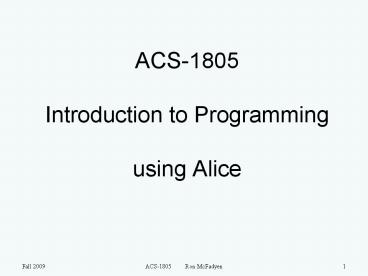ACS1805 Introduction to Programming using Alice - PowerPoint PPT Presentation
1 / 14
Title:
ACS1805 Introduction to Programming using Alice
Description:
The basics of computer programming. Page 5/6/7 in 1st edition. Pages 5/6/7/8 in 2nd edition ... Is a blueprint for objects size, color, actions, ... Programming ... – PowerPoint PPT presentation
Number of Views:50
Avg rating:3.0/5.0
Title: ACS1805 Introduction to Programming using Alice
1
ACS-1805Introduction to Programmingusing
Alice
2
Alice
- The basics of computer programming
- Pages 5/6/7/8 in 2nd edition
- Computer program
- Just a set of instructions for computer to
follow - At its heart, programming is really very
simple. - All computer programs are made from very simple
ideas - A list of instructions (algorithm)
- Ifs (decisions)
- Repeating behaviour (repetition)
- Breaking things into smaller pieces
(decomposition) - Computing a result (functions)
3
Alice
- Flowcharting (2nd edition, page 7)
- terminal
- Input/output
- Processing
- Call
- Decision
- Flow lines
- Connectors on page, off page
- Also chapter 2, page 38, the use of parallelism
later
4
Alice
- Virtual world
- Started by playing a virtual world
- Can play like a movie, or played like an
interactive game - Developing a world begins with a template (e.g.
ground sky) - Object
- Objects are added to the world (e.g. a person, a
robot, a ball) - Objects are chosen from a gallery of 3D models
- Objects are commanded to do things
- 3D Model
- Created by Alice developers
- Is a blueprint for objects size, color,
actions, - Programming
- Build methods containing commands for objects
- Build methods to respond to events
- Event
- Pressing a key on the keyboard, etc.
5
Alice
- Emphasizes programming fundamentals
- Programs are composed of methods
- Methods contain Alice instructions
- Objects are asked to do things they know how to
do - Events can trigger execution of program
components - Programs always run
- The Alice editor is user-friendly its a smart
editor with visual drag drop features
6
Kinds of Animations
- Two kinds
- Movie
- Passive user watches the animation
- Interactive
- Active user clicks on mouse, types a key on
keyboard make into a game - Actions of user are called events
7
Appendix A
- Read both appendixes (especially A at this time)
- Appendix A
- Part 1 Running virtual worlds
- Explains some things about the Alice startup
- World 1
- Open and play the first example in the textbook
tab - World 2
- Open and play the second example in the
textbook tab - World 3
- Creating a new world from the snow template
adding arranging objects - Part 2 using popup menus for the initial scene
8
Appendix B
- Appendix B
- Searching the gallery
- Creating your own people models
- Using the clipboard
- Deleting code using wastebasket and dissolve
- Exporting code to html
- Exporting a world (viewing a world on the web
requires the user to have Java 3D or Java Media
Frameworks installed)
9
Techniques and Tools
- Setting up a world
- Gallery is used to
- obtain objects
- Mouse is used to
- approximately position objects in the scene
- Camera Navigation is used to
- set the camera point of view
- Drop-down menu methods are used to
- resize objects
- position objects in the scene
- Quadview is used to
- position one object relative to another object
- precise positioning of objects in the scene
10
Objects
- An "object" is
- any thing that can be identified as unique from
other things - How is an object unique?
- has a name
- has properties
- width, height, color, location
- can perform actions (methods)
- associated actions it can perform
- tasks it can carry out
11
Galleries
- Classes (3D models) are found in the galleries
- Local gallery (installed with the software)
- Minimum or complete options
- CD Gallery (when CD is in the machine)
- Web gallery
12
Object Parts
- Objects may be composed of parts
- aliceLiddell has a rightArm
- The rightArm comprises a shoulder, and forearm,
and the forearm has subparts too. - A means there are subparts that can be listed
by clicking on the - A - means the subparts are listed. To suppress
the listing of subparts click the - - The picture on the right is showing the objects
in a tree view
13
Object Parts
Consider the aliceLiddell object to the right. A
computer scientist typically uses tree diagrams
for complex hierarchical structures. Can you
complete this for neck and lowerBody?
aliceLiddell
rightArm
leftArm
neck
lowerBody
shoulder
forearm
forearm
shoulder
hand
hand
thumb
fingers
thumb
fingers
fingerTips
fingerTips
14
3 Dimensions, 6 Directions
up
- A 3D object has
- 3 dimensions
- height, width, depth
- 6 degrees of freedom
right
backward
forward
left
down































